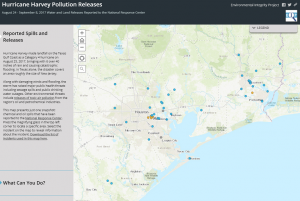
Incidents Recorded by U.S. Coast Guard National Response Center Include Spills of 100,000 Gallons of Glycerine and 10,988 Barrels of Gasoline During Houston Flooding
Austin, TX and Washington, DC – Along with damaging winds and flooding, Hurricane Harvey raised public health threats from sewage spills, public drinking water outages, and releases of toxic air pollution from the oil and petrochemical industries.
The Environmental Integrity Project (EIP) downloaded data from the U.S. Coast Guard National Response Center to create an interactive map of reported chemical and oil spills onto land and into the water caused by the hurricane.
The data used in this map is partial and includes only reports of significant releases made to the center by the public and companies from August 24 to September 8, and does not include all pollution releases. In particular, the map does not include air pollution. (An air pollution map was published September 8 in The New York Times).
Examples of pollution releases on the EIP map include a spill of about 100,000 gallons of glycerine and 80,000 gallons of methyl alcohol into floodwaters at the Channel Biorefinery and Terminals at 13605 Industrial Road in Houston, reported on September 1; and a spill of 10,988 barrels of gasoline into the Houston Ship Channel from the Magellan Pipeline Co. at 12901 American Petroleum Road reported on September 3.
State Waiver vs. Federal Reporting Requirements
Federal laws require the reporting of all unauthorized releases of pollution, whether those releases are to the air, water, or land.
Texas Governor Greg Abbott on August 23 issued a proclamation temporarily waiving several pollution control and reporting laws to the extent that Hurricane Harvey made compliance with those laws impossible. However, the governor’s proclamation acknowledges that the state lacks any authority to waive federal laws.
Some of the state laws the governor waived are also federal requirements. For example, all of the Texas state air pollution reporting requirements contained in Governor Abbott’s proclamation are also contained in federal law. Industrial sources, therefore, have been and remain under a legal obligation to report all releases of contaminants.
Reporting all pollution before, during, and after a crisis is critical to protect the public and the emergency responders who rely on the information to protect themselves from harmful exposure. In addition, pollution reports help local, state, and federal officials identify and prioritize neighborhoods, waterways, and businesses that need to be monitored or cleaned up.
EPA maintains a list of all chemicals subject to reporting requirements under federal anti-pollution laws. Any release of a listed chemical that is not duly authorized – including accidental spills – must be reported as long as they are above a “reportable quantity” established by EPA. For example, any spill involving one pound or more of mercury must be reported, and any spill of 500 pounds or more of sulfur dioxide must be reported.
What Residents Should Do
Members of the public should avoid contact with flood waters and report any evidence of pollution such as oily sheens or strong chemical odors. To report an oil or chemical spill, or air pollution, people should call the National Response Center at: 800-424-8802
To report any pollution concern, members of the public can also call the Texas Commission on Environmental Quality’s 24-hour hotline at: 888-777-3186
About the Data in the Map
Readers can download the list of incidents used to create the EIP map here. Click on the dots on the map below to reveal information about each incident. Select the magnifying glass in the top left corner to search for a specific geographic area. View the full-screen map here.
With the exception of coordinate data, the information presented in the EIP map directly reflects the information in the National Response Center (NRC) database. Any missing information is due to gaps in NRC’s data. EIP determined coordinates based on location data in NRC’s database, and has indicated when coordinates were approximated and may not be exact locations.
Media Contact: Tom Pelton, Environmental Integrity Project (202) 888-2703 or tpelton@environmentalintegrity.org


